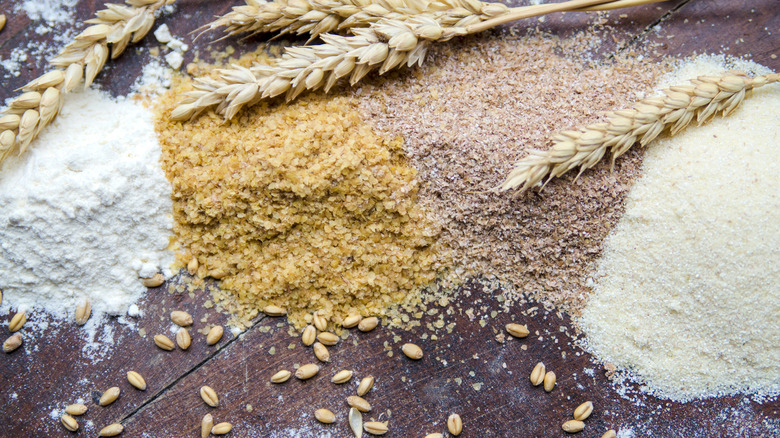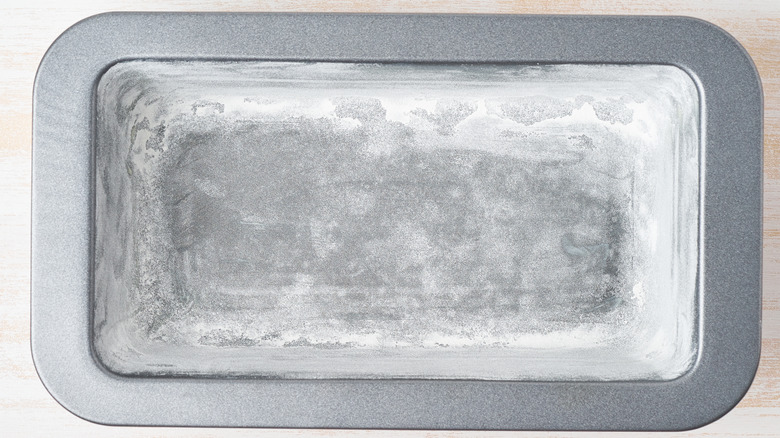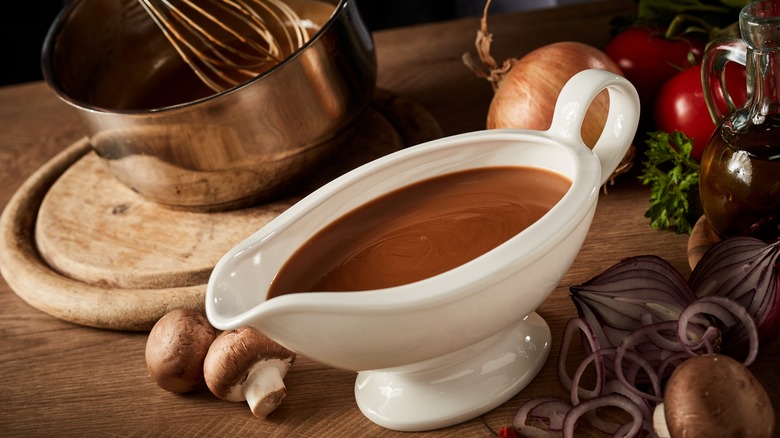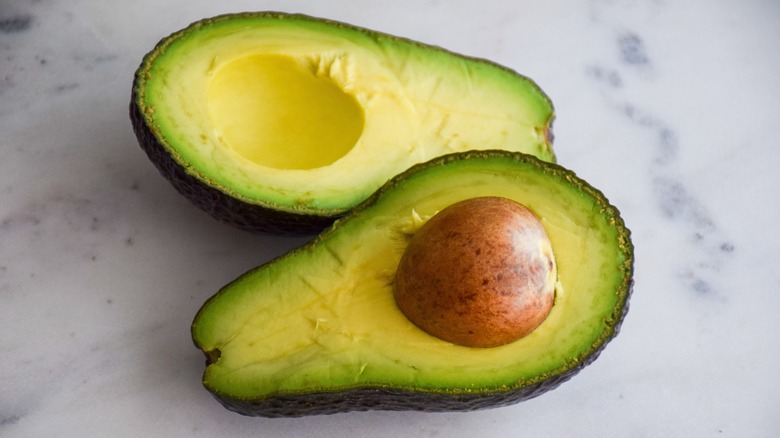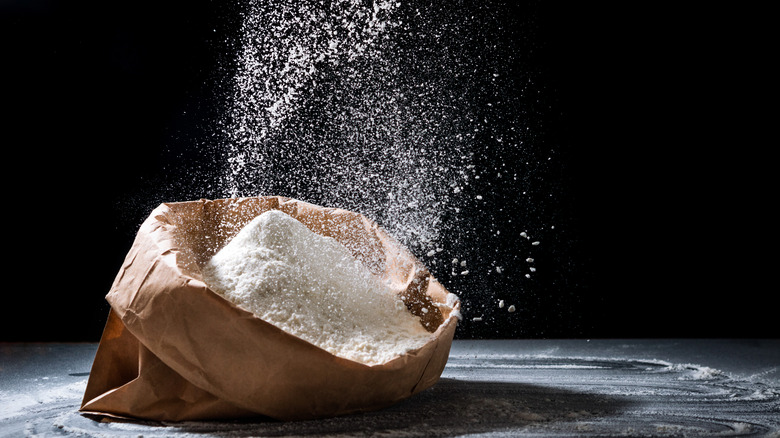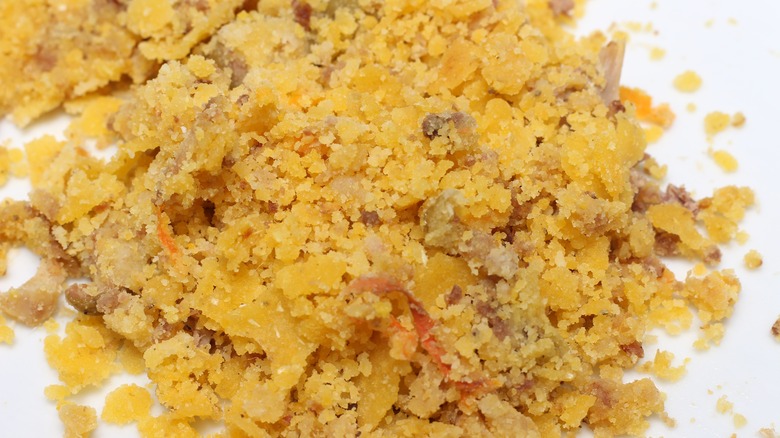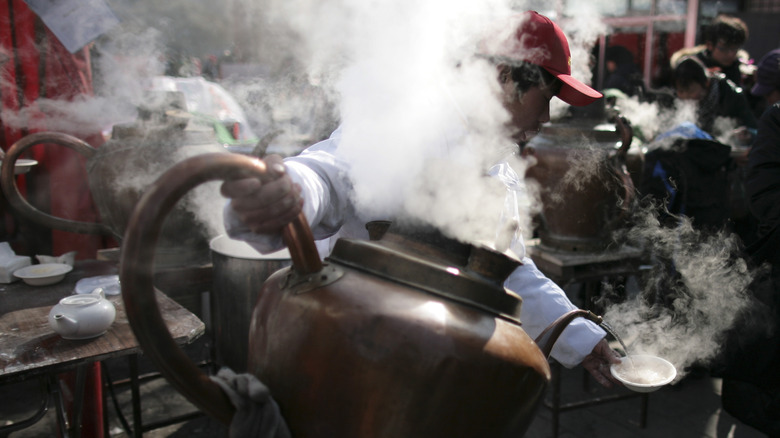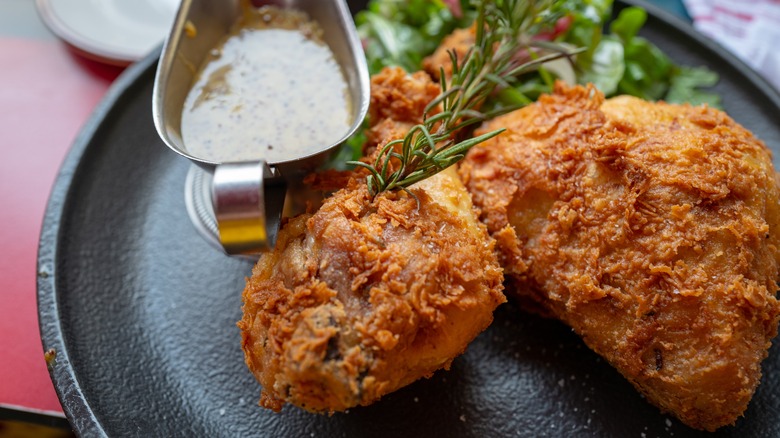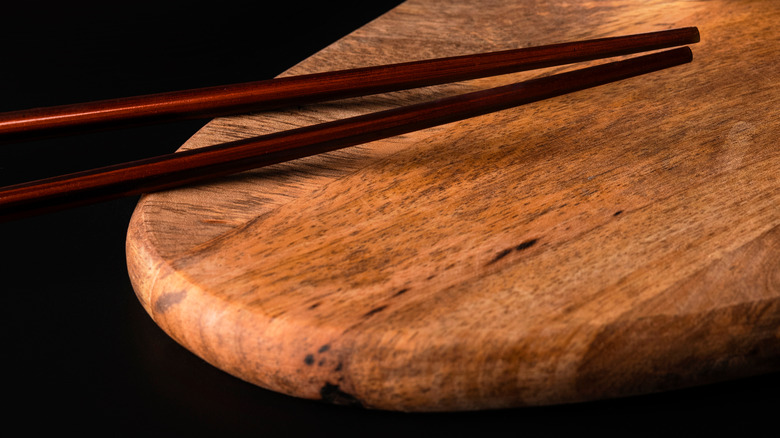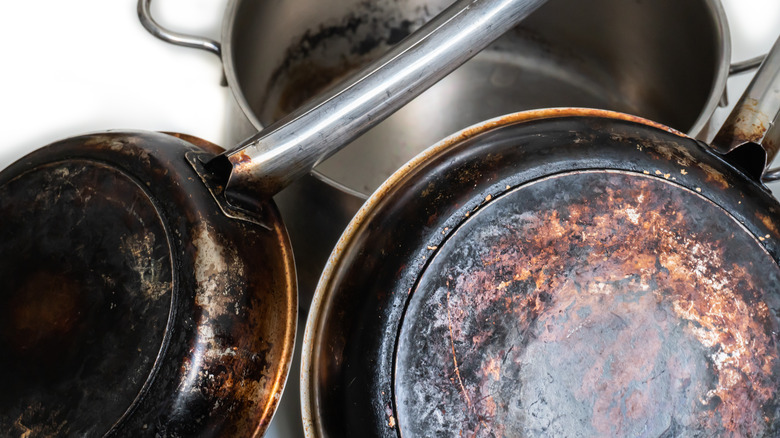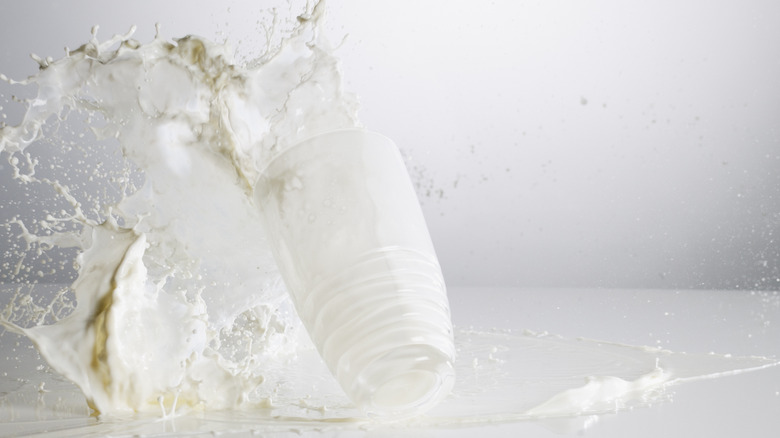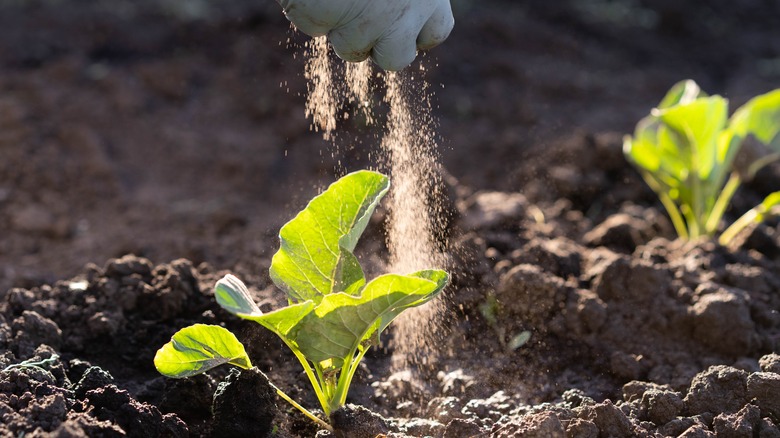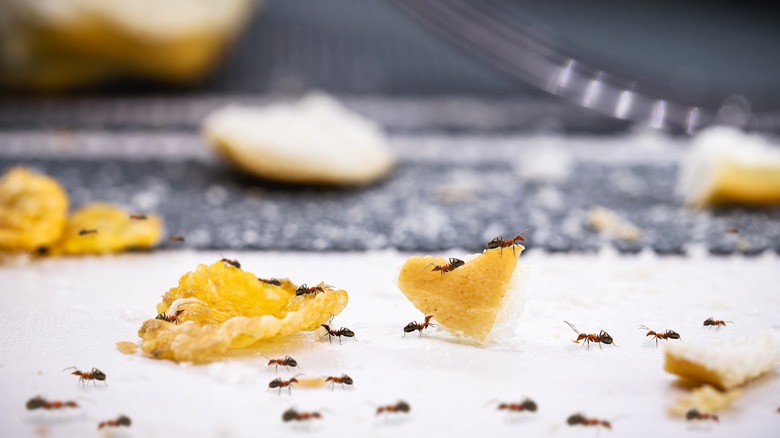12 Flour Hacks You'll Wish You Knew Sooner
"Flour power" isn't a common colloquialism with that spelling, but while flour doesn't have the same scent as a rose or daffodil, when it comes to food, flour doubles down with its ability to elevate numerous meals. Most people associate flour with baking. It is the key ingredient for making most dough, and diverse types of flour can be used for creating different varieties of bread and other baked goods. From flat pie crusts to self-rising biscuits, flour's power rests largely in the oven-warmed doughs produced with it.
However, flour is more versatile than it seems. Its deceptively simple powdery texture is a magnet for almost any type of moisture, and its plant-based origins underscore its compacted nutrients and minerals. A survey of flour hacks from the internet, plus a few gleaned from personal experience, shows how flour can be used in and out of the kitchen, deserving a place as a mainstay in the pantry, cleaning closet, and gardening shed.
Keep your baking pans nonstick
This hack is pretty common, but it bears repeating. Flour is an essential ingredient for dough, but a sprinkle of extra flour can also help prevent your cake from sticking to the pan and keep your cookie cutters working well. When the instructions call for greasing a pan, sprinkling some extra flour on top of the oil or butter can help prevent batter from sticking to the edges before or after baking. The flour creates a coating on metal surfaces to discourage your cakes and cookies from bonding with them. This way, your perfectly round cake won't lose a corner when the mold is removed.
While using a flour coating is one of the best ways to prepare a pan for baking, one note of caution is to avoid using too much flour. The flour stays as-is throughout the baking process, which means that you might end up with a thin layer of flour where your baked goods meet the mold. For cakes that are airy, there might be some flour tucked away in air pockets and folds. One way to avoid having floury goodies is to remove any excess flour that doesn't stick to the pans before adding your batter.
Thicken sauces and gravies
"Good gravy!" might be your exclamatory cry when your first-time DIY meat sauce turns out to be runny, cascading down your masterpiece roast like water. But before running out to the local grocery to buy a jar of the pre-made stuff, take a breather and reach for your handy bag of all-purpose flour to help salvage any thin gravy.
Creating a slurry is a simple way to thicken runny gravy. Basically, add some flour to a small portion of the gravy outside the pot and mix. Using a bit of the gravy will help prevent flour clumps from forming. When the slurry is complete, pour it slowly back into the main gravy pot, which will thicken the whole thing. If it's still not thickened enough, just repeat the process.
Flour is a pretty good thickening agent for any meat sauce, not just gravy. If you're making a stew, flour will help the sauce remain thick and rich. With the help of flour, your dinner guests may also shout out "Good gravy!" — and they'll mean it.
Ripen avocados faster
An avocado a day might keep the pounds away, because this fruit is rich in monounsaturated fatty acids and dietary fiber. But it can be hard to enjoy an avocado when it's unripe and rock-hard. The obvious solution is to simply wait until the avocados ripen on their own, but it can take days before they're ready.
There's actually an easier way to encourage an avocado to mature: treat it like buried treasure and leave it in a sealed bag of flour for a couple of days. The flour hack to quickly ripen an avocado works by creating an airtight seal by which its ripening agent, ethylene, stays within the fruit rather than dispersing when released. An airtight container can lead to mold when moisture is trapped on the fruit's surface, but flour can absorb those droplets, keeping the avocado dry. In two days, the avocado should be ripe enough to enjoy.
Sadly, this flour hack isn't a two-for-one deal. If you're also hoping to make some avocado-infused matcha gingerbread cookies with your newly avocado-scented flour, please reconsider. The avocado may contaminate the flour during the ripening process, so it's best to just toss the powder out rather than use it for your next culinary creation.
Use a jar to sift flour with less mess
Sifting flour is a tried and true guarantor of kitchen messes. Sifting is crucial if you're aiming to make dough light and airy, but it can also turn into a recipe for countertop confetti as the flour powder flies everywhere but the targeted bowl. One simple tip to avoid going overboard when flour dusting is to use a sieve or colander, but even then, flour can still rain down in a powdery torrent, blanketing the counter in a plume of dust. A sieve is a great starting point, but we can amp it up with an everyday accessory to control the flow.
Here's where you can use a simple jar hack for sifting flour without making a mess. As described by Lizzie Acker of "The Great British Bake Off" fame on Instagram, a simple jar with a wide mouth is good for controlling your flour dispersal. Place the desired amount of flour into the jar, and then place your sieve over the jar's mouth. Flip the jar and sieve over while holding them together, and the container will limit the flow and direction of your flour downpour. With a steady hand, you'll prevent the flour from falling everywhere. While some chefs might miss the traditional flour smudge on the brow as a sure sign of kitchen toil, you'll more than make up for that with saved flour, extra time, and less of a mess to clean up.
Use flour as a flavor enhancer
When prepping an apple dessert, a crumb topping is the figurative icing on the cake. A bit of flour mixed with brown sugar, spices, baking powder, and butter can add the perfect combo of crunch and sweetness to complement the fruit filling.
But a flour topping isn't exclusively for desserts. In Brazilian cuisine, farofa (also called cassava flour) is a flour-crumb mix that can be used as a side dish for many main courses to add flavor and texture to suit any diner's individual palate. It's also really simple to make. According to Brazilian Kitchen Abroad, just take 1 cup of cassava flour — which comes from yuca — and spread it over frying bacon fat mixed with about 2 tablespoons of butter. The flour is pan-fried and soaks up the bacon's aroma and juices to reach the consistency of breadcrumbs. Add any additional spices or seasoning to taste, such as garlic. Farofa is a great addition to a meal, especially when savoring rice the Brazilian way.
Create a popular Asian street food
When a clump of flour combines with water, the usual result is a sticky concoction of dough. For many cooks, this is just the first step for preparing warm baked goods that will rise in the oven.
But under the right conditions, flour and water can lead to another delight: chatang (literally meaning "tea soup"), a popular flour-based snack in China. The name might be a bit misleading, as no tea leaves are actually used, and the dish is more like a porridge or gruel than a soup. However, chatang has a proud history. According to China Daily, the recipe dates back to the Ming Dynasty and is made from a combination of hazelnut flour and sorghum rice flour, while customizable flavor-boosting toppings include sesame seeds, walnuts, pine nuts, raisins, and brown or white sugar. This street-food staple of Beijing is prepared by pouring hot water over the flour mixture before adding the toppings. Food vendors who sell chatang can be identified by the large copper kettle they use to pour hot water with a performer's flourish onto the tasty flour concoction.
Make fried food even crispier
When it comes to making our favorite meats crispy, the preferred method is frying. The prime ingredient in frying batter is, of course, flour, which not only puts the crunch in the coating for your fried chicken, but also creates the texture that makes it finger-lickin' good. And that's just the start. Among the many ingredients you should be adding to your fried chicken to take the flavor to the next level, using cornstarch or vodka will create a crispier fried chicken coating.
But flour actually goes both ways. Not only can a flour batter make your chicken crispy when it's fried, but an extra coat of flour can also make fried food even crispier. That's one reason why you should start flouring your bacon if you want to experiment with its flavor and crunchy texture. The added flour will absorb some of the excess moisture from your bacon strips as you brown them, leaving them ready to fry to a crisp. The snug powdery jackets also act to protect the meat's exterior and absorb extra grease, stiffening the bacon and preventing excess curling.
Use wooden chopsticks to fluff flour
One of the hassles of using flour is that it tends to clump up over time. When flour does start clumping, it might seem like no biggie at first, but this compressed flour can affect the measurement of your ingredients by altering the volume of flour in your measuring cup. That's why fluffing flour before baking is so important, especially when your recipes call for exact measurements.
Here's where the chopsticks come in. Keeping a wooden chopstick in your flour will save you time by reminding you to break up your flour in its container so that there are no clumps. The wood in the chopstick is non-reactive, which means it won't alter the taste or quality of your flour. Plus, the chopstick's long shape is the perfect stirrer, and you won't have to reach for a spoon or another tool to break up those clumps. Your chopstick can also be used to level off your measuring cup, so that the volume of fluffed flour is exactly the right amount for your recipe.
Degrease your pots and pans
Pots and pans can wear their grease stains like badges of honor in their line of duty. But for cooks who prefer to keep their pots and pans spic and span, those grease stains have to go. The trade-off for a clean kitchen is the effort put into scrubbing and polishing those metal surfaces to restore their gleam. For some, the high cost for this all-day affair can be sore fingers and dishpan hands.
One way to speed up the polishing process is to enlist your bag of all-purpose flour. Reach for flour the next time your stainless steel sink needs a polish, before sprinkling some flour onto the surface and giving it a good wipe. Make sure the surface is dry, or water drops will cause the flour to clump up into sticky dough, creating one more mess to clean up. The dry flour will absorb grease and dirt from the metal surface, which can then be wiped away with a moist paper towel. This is one of many clever hacks to clean your kitchen sink, and flour can be applied to clean any stainless steel surface, including pots and pans.
Soak up kitchen spills
A watched pot never boils, but a tipped-over pot can be a health and safety hazard. When spills do occur, our first impulse is to get the mop and bucket, but sometimes that's the wrong approach. A mop can actually spread a spill, and if the spill contained oil, mopping it up with water won't get the job done.
One easy trick for quickly cleaning up spilled oil, or any spill, is to head to the pantry for your bag of flour. Flour will absorb any liquid, including oil, which makes it handy for containing the spill's borders and making sure it doesn't spread. While wet flour can clump up and look like the mess is just getting bigger, the mixture is easier to clean up than liquid alone — just add enough flour to the mess so you can sweep it up with a broom. One cautionary note: For hot liquid, it might be best to wait for it to cool a bit before sweeping it up, to avoid accidental burns. Sprinkling a generous layer of flour over hot oils and liquids will help make sure that the spill can safely chill.
Fertilize your herb garden
When quite-contrary Mary was asked how her garden grew, she apparently avoided mentioning a secret ingredient: flour. Not only does flour make baked goods possible, it can also bring good things to life in your garden. According to GrowVeg, flour is rich in nitrogen — which is crucial for growing plants — and different types of flour can act as fertilizer for your garden with varying nitrogen levels. We're tempted to make a joke about self-rising flour being the most effective, but setting aside the humor, flours made with chickpea, whole wheat, and brown rice are considered as being the most rich in nitrogen, and thus best for making plants start rising toward the sun.
But don't just sprinkle flour over your lawn and water it. That can turn into dough pretty quick. Rather, add small amounts to compost and mix well. That way, the flour is dispersed more evenly throughout the soil while being less likely to draw pests.
Stop ants from invading kitchens and picnics
If there's one thing that perplexes many cooks, it's when uninvited guests drop in. When your spouse unexpectedly brings home the boss, the silver lining might be that a raise or promotion is in the future. But when the visitors happen to be ants marching in single file to sack the pantry for a midnight snack or spread out across the counter for scraps, it's time to reclaim the kitchen.
Our immediate reaction to get rid of ants is to bring out the can of Raid or to call the local exterminator. But spraying poison where food is prepped, served, and eaten isn't safe or appetizing, and shopping for pesticides and dialing the bug guy can be a time-consuming expense. Instead, consider flour as the perfect line of defense. Ants are reluctant to cross flour barriers — flour breaks up their scent trails, and ingesting flour may fatally overwhelm their stomachs when the flour expands. Since ants shy away from flour, we can use our powder lines to direct them elsewhere. Strategically placing flour around cracks and holes in the kitchen can deter ants from roaming in, and even flouring their paths outside your home can help dissuade them from entering in the first place. And flour perimeters aren't just for home use; lines of flour around picnic blankets can also help to keep those critters away. Far from just conventional oven use, flour can flourish inside and outside of the kitchen.
